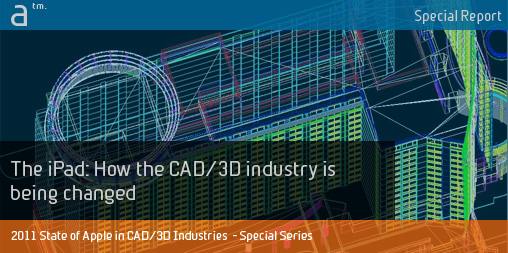Of the various articles in this feature series, perhaps it is the iPad article, our second in the series this week, that looks farthest afield to view a future in computing where architects, engineers and design-related people reshape our world using entirely new work flows. These will be built around new types of tools and accessing design and engineering data from anywhere one chooses to work.
Loosing the Bow Line
The future of design and creation is about it being untethered from the studio from which it traditionally came. The bow-line has been untied from the cleat. And design process can now sail away from the common harbor where mutual activity in creation and engineering poured forth.
What we now have in front of us is a new era defined by the synergies between two powerful new technologies. The cloud. And the tablet.
When we talked to our CEOs and experts in this series about the role the iPad could and should play in their industries one theme kept popping up again and again. They see the iPad as the cloud’s partner. Cloud computing has many reasons to exist separate from mobile tablet devices and smartphones, but yet it is the iPad and these new devices that are giving rise to the cloud’s fullest potential. In many ways the two are new dance partners who have just taken to the floor, and as the years move forward, they will stun us with new expressions that we can’t yet even imagine.
Sean Flaherty, CEO of Nemetschek Vectorworks, a global CAD leader and the market-leader in the Mac space, said it rather directly. “Fundamentally, I see the iPad as a cloud device. Without an Internet connection it is a useful device,” he notes, “but connected to the Web it is a dramatically new way of computing.” This view helps shape perceptions of why Apple built its enormous new data center in North Carolina and why iCloud will grow to such large importance in time.
James Scapa, Chairman and CEO of engineering software giant Altair, the makers of market-leading CAE (computer-aided engineering) software and owners of solidThinking, remarked that the iPad “provides a natural means for users to orchestrate and access all their work from wherever they are.”
That “wherever-they-are” is made possible because of the cloud.
What the cloud does is free us. What the iPad does is make it extremely practical to access that information in the cloud. In some ways these two new inventions will help mankind expand in a manner not unlike the history of maritime exploration and the history of the magnetic compass. In this case the iPad is like the large sailing vessels of the medieval world, but it is the cloud that is our new magnetic compass, giving us that omnipresent reference, that marker, enabling a global means to see our world and the information in it and the exact location of where we are and how our data and us fit into it.
The iPad is indeed a vessel of sorts. A breakthrough in mobility with its stunning battery-life and its ideal form-factor. With it we can transport our information, ideas and dreams to any corner of the globe.
This human breakthrough–this combination of the cloud’s omnipresence and the tablet’s great mobility–is not lost on the leaders of the world’s biggest engineering software companies. Carl Bass, CEO of Autodesk, the global leader in CAD, remarked that “fundamentally it’s about the creation of new work flows and new means of access to your information.”
“…so whether you look at this idea of turning photos [from your mobile devices] into 3D models, or AutoCAD WS doing collaboration through the cloud,” notes Bass, “there is just a whole bunch of stuff that wasn’t possible before these new technologies.”
next page: The iPad as a New Vessel





Reader Comments
[…] Is the Ipad actually changing CAD? […]
Comments are closed.